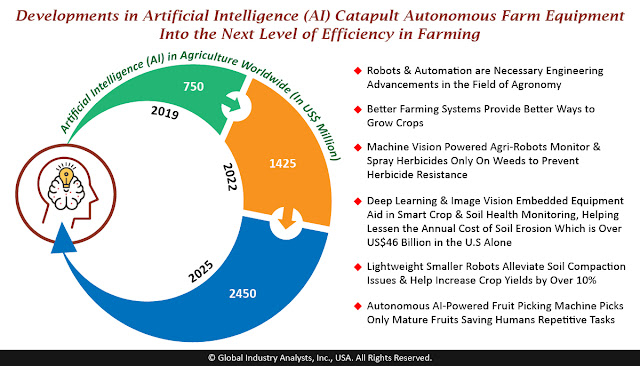The global market for Autonomous Farm
Equipment is projected to reach US$128.8 billion by 2025, driven by growing government
and private sector investments in intelligent agriculture as the future of
sustainable farming. Major factors playing key roles in catalyzing revolutionary
changes in agricultural technologies include growing population and food demand;
escalating shortages in arable land due to soil pollution and use of
agricultural lands for industrialization and urbanization; need to increase
yields per acre; shortage of labor; growing carbon footprint of agricultural
activities; and rising urgency in addressing sustainability issues such as unacceptable
rise in pesticide residues, soil degradation, water wastages, herbicide
resistance in plants, and preventable losses in planting, growing, and harvesting.
All of these factors catalyze the concerns surrounding food security, and opens
up new revenue possibilities and opportunities for automation in agriculture. Achieving
sustainable food security supported by self-sustaining agricultural
mechanization strategy is emerging as the cornerstone for the growth of
automation in agriculture. Benefits of mechanized agriculture practices include
increase in crop yields per acre; increase in agricultural production;
productivity enhancements; increased efficiency of farming; lower costs;
improved farm profitability; enables more land reclamation; prevents soil
erosion; enables the shift from ‘subsistence farming’ to ‘commercial
agriculture; addresses the problem of labor shortages; and better use of land.
All these benefits help in increased crop production thereby increasing food
supply, the key to meeting food security goals. Read More...
The Global Market for Private Tutoring Services is Forecast to Reach US$227 Billion by 2022
Intense Competition among Students and the Growing Need to Achieve Academic Excellence Drive the Global Private Tutoring Market, According to a New Report by Global Industry Analysts, Inc. GIA launches comprehensive analysis of industry segments, trends, growth drivers, market share, size and demand forecasts on the global Private Tutoring market. The global market for Private Tutoring Services is forecast to reach US$227 billion by 2022 , driven by the need to keep pace with classroom teaching, improve overall competency and enhance knowledge and skill level. Education is considered the social ladder to achieve success in personal and professional life. Higher education is associated with increased opportunities in the labor market, high remunerations, and improved social standing. People are therefore investing heavily in children’s education, including private tutoring or private supplementary tutoring which is emerging as a major phenomenon in the global education system...


Comments
Post a Comment